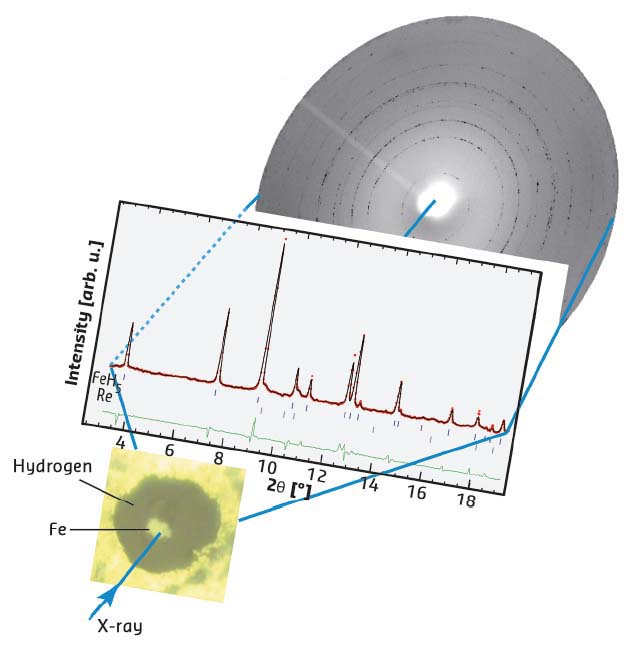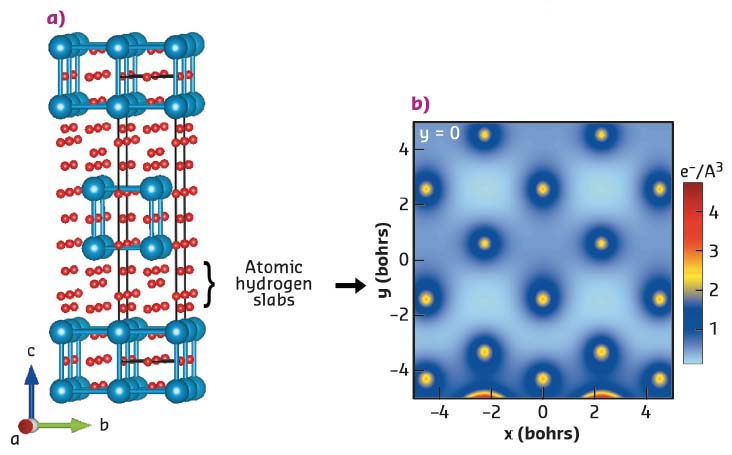- Home
- Users & Science
- Scientific Documentation
- ESRF Highlights
- ESRF Highlights 2017
- Matter at extremes
- Synthesis of FeH5 under pressure: dense atomic metal hydrogen stabilised with Fe
Synthesis of FeH5 under pressure: dense atomic metal hydrogen stabilised with Fe
FeH5 was formed above 130 GPa in a laser-heated diamond anvil cell. It exhibits a remarkable layered structure trapping slabs of atomic hydrogen. This discovery of FeH5 suggests a low-pressure path to make materials that approach bulk dense atomic metal hydrogen.
Pure atomic metal hydrogen is expected to have remarkable properties such as room temperature superconductivity, and other unprecedented quantum many-body properties such as a superfluid-superconductor state. Despite intensive research over the past 40 years, atomic metal hydrogen has yet to be observed unambiguously. Atomic metal hydrogen should be stable above 450 GPa. However, it is still a formidable experimental challenge to reach such a pressure and then to characterise the properties of a sample just a few µm in size.
A decade ago, N. Ashcroft suggested that the high-temperature superconductivity of atomic metal hydrogen should be observed in hydrogen-dominant metallic alloys [1]. Due to the chemical pre-compression effect, the attainment of these metallic alloys should be within the usual capabilities of the diamond anvil cell.
This paper has stimulated an intense theoretical structural search. A novel view on the chemical combination of hydrogen with metals under pressure has been unveiled: the solubility of hydrogen in metals drastically increases under high pressure; hydrides of metals go from interstitial complexes to compounds formed with non-traditional H stoichiometries, dubbed super-hydrides. Many of the superconductivity temperatures calculated for these super-hydrides are indeed high, some even approaching ambient temperature.
So far, only a few experimental studies have been devoted to superhydrides. Yet, the richness of this line of research has been recently confirmed by the discovery of superconductivity in hydrogen sulfide at a Tc of 203 K at 150 GPa, explained by the formation of H3S [2]. However, for high hydrogen concentrations, H atoms usually form complex hydrogenic sub-lattices composed of H–, H2, H3– and cages. It remains unknown whether a super-hydride could exist that is a real analogue of metal hydrogen, i.e. that exhibits a dense sub-lattice of hydrogen atoms.
The discovery of FeH5 is the first observation of such an analogue of atomic metal hydrogen. FeH5 was synthesised by a direct reaction of Fe and H2 above 130 GPa (a pressure of ~1.3 million atmospheres) in a diamond anvil cell. This compound consists of intercalated layers of quasi-cubic FeH3 units and of slabs of atomic hydrogen (see Figure 35). The ab initio calculations show that no bonding exists between these H atoms. The atomic H slabs interact with the Fe atoms to stabilise dense atomic H at much lower pressure than in pure hydrogen and FeH5 is a metal within its layers.
The experiments were performed at ID27 using an online laser-heating set-up. Superhydrides were synthesised by compressing iron in excess hydrogen with laser heating to ease the diffusion of hydrogen into the metal. This permitted the hydride with the highest stoichiometry and stable at a given pressure to be observed. Between 3.5 and 125 GPa, the known interstitial stoichiometric compounds FeH, FeH2 and FeH3 were observed [3]. Above 130 GPa, laser heating of iron in excess of hydrogen permitted the synthesis of FeH5 and its equation of state was measured by decreasing the pressure down to 66 GPa, after which it decomposed back to FeH3.
 |
|
Fig. 34: Picture of the sample with the resulting X-ray diffractogram showing the Rietveld refinement of the tetragonal FeH5 structure. |
Rietveld refinement of the new X-ray pattern yields a tetragonal unit cell with symmetry I4/mmm (Figure 34). Only the position of the Fe atoms can be inferred from the X-ray diffraction patterns as the low scattering power of the hydrogen atoms prevents the determination of their position. However, using volume comparisons with ideal Fe-H solutions, it is possible to propose that the stoichiometry of the new compound is that of FeH5. Ab initio calculations supported the FeH5 stoichiometry: all possible tetragonal structures with the determined Fe atom positions were tested. Among the 53 optimised structures, the one presented in Figure 35 has the lowest enthalpy and exhibits cell parameters in good agreement with the ones measured experimentally.
 |
|
Fig. 35: a) Structure of FeH5 showing the presence of atomic hydrogen slabs. b) Electron density map along the c axis: no bonds between the hydrogen atoms can be found. |
These results show that the Fe-H system is an archetype of how hydrogen can combine with transition metals under pressure. At moderate pressures, structures consisting of interstitial hydrogen are formed. At higher pressure, slabs of atomic hydrogen can then be stabilised, thus suggesting a path towards bulk dense atomic hydrogen at low pressure. A little bit of Fe could do a lot to help unveil the intriguing properties of atomic metal hydrogen.
Principal publication and authors
Synthesis of FeH5: a layered structure with atomic hydrogen slabs, C. M. Pépin (a,b), G. Geneste (b), A. Dewaele (b), M. Mezouar (c) and P. Loubeyre (b) Science 357, 382-385 (2017); doi: 10.1126/science.aan0961.
(a) CEA, Arpajon (France)
(b) EPSL, Institute of Condensed Matter Physics, EPFL, Lausanne (Switzerland)
(c) ESRF
References
[1] N. W. Ashcroft, Phys. Rev. Lett. 92, 187002 (2004)
[2] A. P. Drozdov et al., Nature 525, 73-76 (2015)
[3] C. M. Pépin et al., Phys. Rev. Lett. 113, 265504 (2014)



